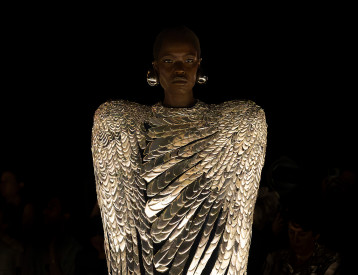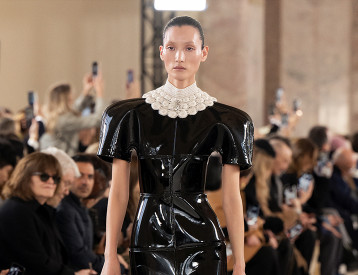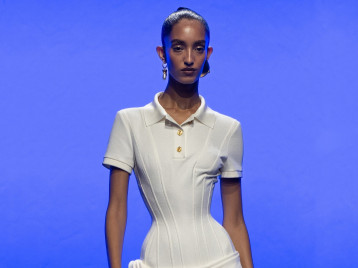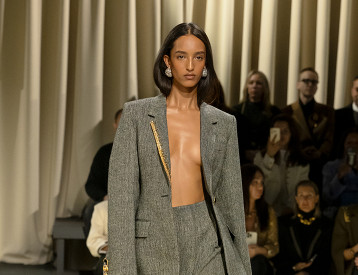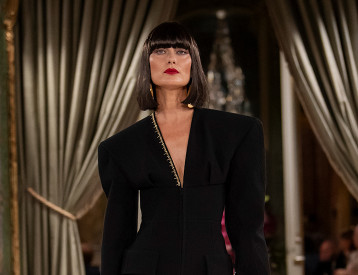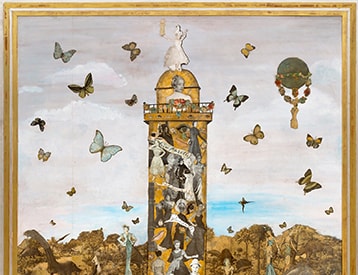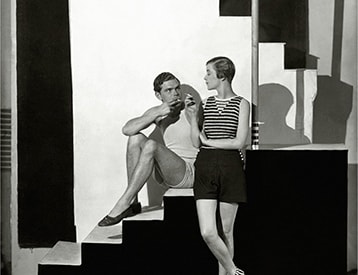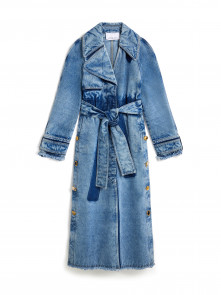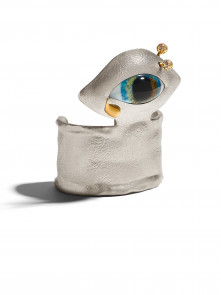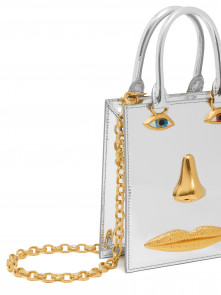Elsa Schiaparelli was born in 1890, in the Corsini palace in Rome. With a father who was the director of the Lincei library and a professor of Oriental literature, an astronomer uncle and a mother descended from the Medicis, she grew up in a family of aristocrats and intellectuals. She studied philosophy, even though her dream was to become an actress. In 1911, she published a collection of overtly sensual poems, Arethusa. When her parents learnt about it, she was sent to a convent in Switzerland, where she left again after going on hunger strike.
1911
Elsa publishes a collection of overtly sensual poems, Arethusa.
1913 marked the year of emancipation. She set off for London with one of her sister’s friends to help to look after her children. This city proved to be the beginning of freedom. When she was attending a conference on theology by Count Wilhelm Wendt de Kerlor, she felt under the charm of this young theosophist. They married in 1914 and left London for New York in 1916, after spending several seasons in Nice.
Palazzo Corsini, Rome
On the liner taking them to New York, Elsa formed a friendship with Gabrielle Picabia, the wife of the Dada painter. This encounter would introduce Elsa into the circle of the avant-garde artists of the time:
Man Ray
Marcel Duchamp
Edward Steichen
Marcel Duchamp
Edward Steichen
The young couple lived on Elsa’s dowry, which was disappearing at the speed of light. Their daughter Yvonne, nicknamed Gogo, was born in 1920 and very soon contracted poliomyelitis. Juggling her Bohemian lifestyle, part-time jobs, her husband’s repeated absences and taking care of her daughter, Elsa asked for a divorce.
In 1922, she moved to Paris with her daughter because Europe seemed to be ahead in terms of the treatments that Gogo needed. During the day, Elsa worked at an antique dealer’s. In the evening, she frequented the famous restaurant, Le Bœuf sur le Toit, which attracted the Paris smart set. Her circle of artist friends grew. One day, Elsa accompanied a friend to a fitting at Paul Poiret, the greatest couturier of the age. She tried on a few designs while she was waiting, even though she couldn’t afford to buy such pieces. Realising this and no doubt sensing that such an atypical woman would be a good advert for his clothes, Paul Poiret suggested that Elsa could borrow several designs. This experience of a couture house, luxury, quality, design, colors, materials, embroidery and shapes lit a spark in Elsa that would prove to be one of the turning points in her life.
In 1922, she moved to Paris with her daughter because Europe seemed to be ahead in terms of the treatments that Gogo needed. During the day, Elsa worked at an antique dealer’s. In the evening, she frequented the famous restaurant, Le Bœuf sur le Toit, which attracted the Paris smart set. Her circle of artist friends grew. One day, Elsa accompanied a friend to a fitting at Paul Poiret, the greatest couturier of the age. She tried on a few designs while she was waiting, even though she couldn’t afford to buy such pieces. Realising this and no doubt sensing that such an atypical woman would be a good advert for his clothes, Paul Poiret suggested that Elsa could borrow several designs. This experience of a couture house, luxury, quality, design, colors, materials, embroidery and shapes lit a spark in Elsa that would prove to be one of the turning points in her life.
In Paris, the most famous Couturier of the age,
Paul Poiret,lends her several designs.
Paul Poiret,lends her several designs.
Credits :
Elsa Schiaparelli by George Hoyningen-Huene © Condé Nast Archive/Corbis ; Elsa Schiaparelli with her dog © Austrian Archives/CORBIS.
Elsa Schiaparelli by George Hoyningen-Huene © Condé Nast Archive/Corbis ; Elsa Schiaparelli with her dog © Austrian Archives/CORBIS.
In the mid-1920s, Elsa Schiaparelli let her creativity flourish and became a freelance designer. She joined forces for a time with a friend who had acquired a brand that had fallen into decline. Elsa soon regained her independence so that she could express herself to the full. Her simple yet radical, ingenious idea was a hand-knit pullover with a black and white trompe-l’œil motif. This sweater was immediately deemed a “masterpiece” by Vogue and the United States made it a star product within a few months.
Although she founded her company in her own apartment in 1927, the business really took off the following year when she set up ateliers, salons and offices at 4, rue de la Paix with “Schiaparelli – Pour le Sport” (Schiaparelli – Sportswear) on the door plate. The collection of knitwear pieces was fleshed out with swimsuits, beach pyjamas and accessories. The motifs became more varied (abstract tortoises, skeletons, sailor tattoos, etc.), as did the colors, playing on contrasts (black and white, black and bright shades). This blend of Haute-Couture and sportswear had such an impact across the pond that American textile manufacturers offered her her first licensing agreements.
From 1929 onwards, she introduced a growing number of innovations in terms of materials, cuts, details and accessories: a raincoat in rubberised wool and silk, jumpsuits with visible zips (which would later be followed by colored zips and then multi-colored versions), the first evening dress (a wrap dress with a plunging neckline), culottes (which would cause a scandal in England), strong-shouldered suits (the ancestor of the power suit), reversible black and white evening dresses, aerodynamic cuts created by skilfully placed flounces, eccentric hats (such as the Mad Cap, which was copied to such an extent that Elsa would almost regret having designed it), and a licence in the United States for metal mesh bags.
Her simple yet radical,
ingenious idea was
a hand-knit pullover with a trompe-l’œil motif.
The first collaborations
supported Elsa Schiaparelli’s
prolific creativity.
supported Elsa Schiaparelli’s
prolific creativity.
From then on, the collections followed hot on the heels of each other at the rate of four presentations a year. The first collaborations supported Elsa Schiaparelli’s prolific creativity: an aspirin porcelain necklace with Elsa Triolet; a trompe-l’œil pleat painted on a long dress with the painter Jean Dunand; jewellery with Alberto Giacometti; a metal and fur bracelet with Meret Oppenheim, to name just a few. Research into the development of new materials led to revolutionary fabrics such as rhodophane (as transparent and fragile as glass) or crushed rayon crepe (resembling tree bark). Elsa surrounded herself with the best talents: Jean Schlumberger, Jean Clément and then Lina Baretti for jewellery, Jean-Michel Frank for the decoration and design of the fragrance bottles, Pérugia and Roger Vivier for shoes, Lesage for embroidery, and Marcel Vertès and Raymond Peynet for advertising.
Elsa surrounded herself with
the best creative talents:
the best creative talents:
Elsa Triolet
Alberto Giacometti
Meret Oppenheim
Jean Schlumberger
Jean-Michel Frank
Marcel Vertès
Jean Dunand
Jean Clément
Raymond Peynet
Alberto Giacometti
Meret Oppenheim
Jean Schlumberger
Jean-Michel Frank
Marcel Vertès
Jean Dunand
Jean Clément
Raymond Peynet
Credits :
Elsa Schiaparelli by George Hoyningen-Huene © Condé Nast Archive/Corbis ; Elsa Schiaparelli by Horst P Horst © Condé Nast Archive/Corbis.
Elsa Schiaparelli by George Hoyningen-Huene © Condé Nast Archive/Corbis ; Elsa Schiaparelli by Horst P Horst © Condé Nast Archive/Corbis.
Her reputation was such that she became the first female fashion designer to be featured on the cover of the American magazine Time in 1934. From the outset, Elsa and her designs for women with a strong and independent personality attracted famous customers: Wallis Simpson, the future Duchess of Windsor (whose tousseau would bear the Schiaparelli label), Marlene Dietrich, Katharine Hepburn, Greta Garbo, Lauren Bacall, Gene Tierney, Gala Dali, Marie-Laure de Noailles, Daisy Fellowes, Nusch Eluard (who wore Schiaparelli for her portrait by Pablo Picasso), Arletty, Vivien Leigh, Ginger Rogers, Juliette Gréco, Mae West (for whom she designed the wardrobe of one of her films), to name just a few.
From the outset, Elsa and her designs
for women with a strong and independent personality attracted famous customers: Marlene Dietrich, Katharine Hepburn, Lauren Bacall …
for women with a strong and independent personality attracted famous customers: Marlene Dietrich, Katharine Hepburn, Lauren Bacall …
In 1932, the Couture House, which had become “Schiaparelli - Pour le Sport, Pour la Ville, Pour le Soir” (Schiaparelli – Sportswear, City and Evening Wear), spanned several floors and included eight ateliers accommodating over 400 employees. The following year, Elsa Schiaparelli opened a store and salons in London and an office in New York. After the launch of her first fragrance “S” in 1928, she presented a collection of three perfumes –Soucis, Salut and Schiap – in 1934. The year after, the Couture House took over the Hotel de Fontpertuis, 21 place Vendôme: five floors, 98 rooms, over 700 employees and a ground-floor boutique with a view of the Vendôme column. Elsa had the idea of cutting out press articles celebrating her success to create a newspaper cuttings print.
1934
Elsa Schiaparelli becomes the first female fashion designer
to be featured on the cover
of the American magazine TIME.
Elsa Schiaparelli becomes the first female fashion designer
to be featured on the cover
of the American magazine TIME.
Alongside this economic development, design remained at the heart of Elsa’s activities. She alternated sportswear with restrained lines, “hard chic” suits and day dresses with unashamedly seductive evening dresses. She took her inspiration from the male wardrobe to create the first coat-shirt in 1935. Each collection told a rich story, borrowing from the precious and the ordinary, art and everyday life, the figurative and the narrative, surrealism and referenced symbols, the poetic and the architectural, black and the most striking colors, the provocative and the severe. Elsa handled paradox and complementarity with ease. She was the first to give her collections a theme: the “typhoon” look, the “parachute” look, “Stop, Look & Listen”, “Le Cirque” (circus), “Commedia dell’Arte”, “Païenne” (pagan),“Astrologie”, etc.
The 1930s marked
her most famous collaborations with
Salvador Daliher most famous collaborations with
Jean Cocteau
The 1930s marked her most famous collaborations: Salvador Dali, with whom she created now-legendary pieces (suits with bureau-drawer pockets, a shoe-hat, a lobster-printed dress, a skeleton dress, the tear dress, Le Roy soleil perfume bottle, etc.), and Jean Cocteau, whose drawings featured on coats, evening ensembles and jewellery. The surrealist and artistic spirit took hold of leather ankle boots with toes represented by topstitching, along with the men’s fragrance bottle in the shape of a pipe (in a nod to Magritte), gloves with red python nails, ankle boots fringed with long monkey fur, a Rhodoid necklace incrusted with insects, and handbags with luminous (battery-powered) decorations.
1937 saw the launch of the perfume Shocking and the color “shocking pink”. The perfume, whose bottle designed by Léonor Fini represented a dressmaker dummy following the curves of Mae West, decorated with porcelain flowers and a velvet measuring tape, was an unprecedented success. Elsa then had a chromatic vision: she invented shocking pink, a pure, vibrant, undiluted, intense and lively pigment.
1937
Elsa launchesthe perfume
Shocking
and creates the color
shocking pink
Credits :
Elsa Schiaparelli by George Hoyningen-Huene © Condé Nast Archive/Corbis ; Elsa Schiaparelli © RMN/François Kollar.
Elsa Schiaparelli by George Hoyningen-Huene © Condé Nast Archive/Corbis ; Elsa Schiaparelli © RMN/François Kollar.
This overflowing creativity that shook up sensibilities was soon interrupted by the Second World War. Until the summer of 1940, Elsa fought to keep her Couture House in business in order to maintain as many jobs as possible and even launched a perfume, Sleeping. In view of the air raids, she created practical and comfortable clothing: zippered jumpsuits with maxi pockets intended to hold the equivalent of a handbag, a coat with an integrated bag, transformable dresses, etc.
In July 1940, Elsa left Paris and gave a series of conferences across the United States on the theme of “Clothes and the Woman”. Her audience totaled 36,000 for one of them. In Dallas, she was the first European to receive the Neiman Marcus award for services to fashion.
In July 1940, Elsa left Paris and gave a series of conferences across the United States on the theme of “Clothes and the Woman”. Her audience totaled 36,000 for one of them. In Dallas, she was the first European to receive the Neiman Marcus award for services to fashion.
1940
Elsa was the first European to receive the Neiman Marcus award.
Despite the war and MoMA’s offer to appoint her as director of a fashion design department, she left for Paris again.
She set off with 13,000 vitamin capsules to help Free France. During a stopover in Bermuda, customs confiscated the cargo, suspecting Elsa of smuggling. Her papers finally in order, she could set off again with the vitamins.
She set off with 13,000 vitamin capsules to help Free France. During a stopover in Bermuda, customs confiscated the cargo, suspecting Elsa of smuggling. Her papers finally in order, she could set off again with the vitamins.
Elsa sets off with 13,000 vitamin capsules
to help Free France.
to help Free France.
As her status as an Italian in Paris was becoming risky, she put her Couture House into the hands of her right-hand man from May 1941 to July 1945. She set off to live in New York and continued to help France through many initiatives across the Atlantic.
Credits :
Elsa Schiaparelli by George Hoyningen-Huene © Condé Nast Archive/Corbis.
Elsa Schiaparelli by George Hoyningen-Huene © Condé Nast Archive/Corbis.
When France was liberated, Elsa returned there immediately, took over the designing and presented a collection as early as September 1945. She took part in the travelling exhibition Théâtre de la Mode across the United States. Hubert de Givenchy was hired as the creative director of the Schiaparelli boutique. A perfume factory was built in the suburbs of Paris to ensure the sustained activity of the existing perfumes, complemented by the launches of Roy Soleil, Zut and Succès Fou over the following years.
Elsa caused a sensation with the Constellation wardrobe: six dresses, one reversible coat, and three folding hats, all under 12 lbs.
In 1946, in step with women who were travelling more and more, Elsa caused a sensation with the Constellation wardrobe: six dresses, one reversible coat, and three folding hats, all under 12 lbs. Despite the strike of part of her Haute-Couture ateliers, Elsa presented her collection in August 1949. The pieces were not finished. You could still see pins, fabric swatches and no buttonholes. However, the youthful style, evident daring and the evening dress with a visible bra led the New York Times to describe the collection as “Striking”. Newsweek devoted its front page to Elsa.
Despite these successes, an increasing number of licences in the United States (she was the first to launch a line of designer sunglasses), and good sales for her perfumes, Elsa noted that the world of Haute-Couture had changed. She decided to close her Couture House in 1954 to devote herself to her autobiography Shocking Life. She died in her sleep in 1973.
1949Newsweek devotes
its front page to Elsa.
its front page to Elsa.
Credits :
Elsa Schiaparelli by George Hoyningen-Huene © Condé Nast Archive/Corbis ; Elsa Schiaparelli © Condé Nast Archive/Corbis ; Portrait of Elsa Schiaparelli in her living room by Etienne Drian.
Elsa Schiaparelli by George Hoyningen-Huene © Condé Nast Archive/Corbis ; Elsa Schiaparelli © Condé Nast Archive/Corbis ; Portrait of Elsa Schiaparelli in her living room by Etienne Drian.
